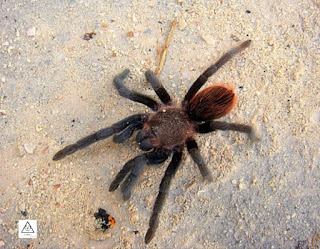Red posterior tarantulas
Red-Posterior Tarantulas are 4 or 5 crawls across (counting their legs) however a few females can get as extensive as 6 inches. The guys are littler than the females. Now and again the female arachnids eat their sweethearts - yowser!
Red-Posterior Tarantula females lay around 300 eggs in a silk casing called an "egg sac". She keeps the egg sac in her tunnel, shielding it from predators until the eggs bring forth. When they bring forth, the spiderlings (child tarantulas) forget about the tunnel going to begin life all alone - mother's activity is done and she gets her tunnel back to herself.
At the point when they are youthful, the spiderlings are earthy colored. When they are grown-ups the guys and females get red hairs on their mid-region (which is the reason they are classified "red-rear end" tarantulas). They look very comparable however the guys are somewhat more brilliant red and the females are somewhat bigger.
Red-Back end Tarantulas carry on with singular lives, for the most part in Mexico yet in addition in certain pieces of Focal America. Most bugs turn networks to live on and get prey yet not tarantulas - they live in tunnels that they delve into the ground. Like different creepy crawlies, they do turn silk from their mid-region, however they utilize this silk to line within their tunnels not to get prey.
Red-Rear end Tarantulas rest in their tunnels during the day and afterward, around evening time, come out to chase. They jump on their prey and rapidly puncture them with venomous teeth like ice-picks. They infuse stomach related juices into their prey that (rapidly) transforms them into such a soup that the creepy crawly guzzles up.
When feeling compromised, the Red-Back end Tarantula raises up, raising its front legs to flaunt their undermining teeth. On the off chance that this doesn't frighten away a foe, the following line of barrier the tarantula utilizes is to flick bothersome little hairs at the foe utilizing their legs. These hairs are designated "urticating hairs" and develop on the tarantula's midsection. It's fundamentally the same as what a porcupine does with its plumes. The urticating hairs have a snare toward the end that tingles and disturbs the skin and conceivably eyes of the adversary. After some time, these hairs can even work themselves more profound into delicate substance.
It's intriguing to take note of that in any event, something the size of a human can have awful inconvenience from a tarantula's urticating hairs. Red-Posterior Tarantulas are regularly kept as pets and there have been situations where individuals get the hairs in their eyes which can cause extraordinary agony and requires a quick visit to an eye-specialist to forestall difficulties.
A most interesting aspect concerning red-back end tarantulas is that they live for such a long time - a female can live for about 20 years. The male's life expectancy is more like 5 years (on the off chance that he doesn't get eaten by one of the females previously, at that point!)

Comments
Post a Comment